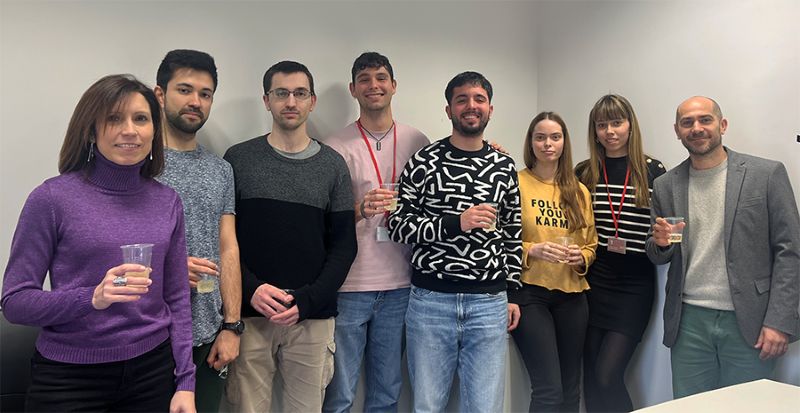Quantitative Cell Biology of Meiotic Chromosome Dynamics
Meiosis is a specialized type of cell division in which from a diploid progenitor cell and after two consecutive nuclear divisions, called meiosis I and meiosis II, four haploid gametes are generated. Meiosis, also known as gametogenesis, is fundamental to generate new allelic combinations that promote the genetic diversity necessary to adapt to changes in environmental conditions. One of the critical steps in safeguarding genetic diversity is recombination between homologous chromosomes during meiotic prophase. The search for homologous chromosomes is facilitated by nuclear movements generated by cytoskeletal forces. Actin and dynein are two of the most evolutionarily conserved motors that generate force to move the nucleus. Nuclear motions are transmitted to chromosomes by telomere bouquet formation, a transient chromosomal configuration in which telomeres are clustered in specific regions of the nuclear envelope, often near the centrosome. Although defects in bouquet formation compromise gamete production and viability, the molecular basis that controls how the beginning and end of the bouquet stage is established, how long chromosome movements last, and whether these movements are stochastic or follow a predictable pattern are some of the questions that remain to be deciphered.
In our lab we try to understand the molecular basis of chromosome dynamics during gametogenesis by developing new computational tools for segmentation and unsupervised time series analysis, spectral evaluation, motif discovery and causal network discovery in chromosome movements in the fission yeast Schizosaccharomyces pombe, one of the model systems in which chromosome dynamics during the telomere bouquet stage has been explored in the greatest detail. In other tools, in the lab we have designed the ChroMo web application which allows us to obtain more detailed information about meiotic prophase in fission yeast and to clearly differentiate phenotypes that were previously indistinguishable by other methods. Another line of interest in the lab is the development of new quantitative approaches to understand chromosomal dynamics within other fundamental stages of gametogenesis, such as the structural steps of bouquet formation itself, spindle self-assembly along meiotic divisions as well as the detection of aneuploidy.
Research lines:
- Modeling the dynamics of chromosome movements and their possible microvariations during meiotic prophase as a consequence of mutations or physico-chemical stresses.
- Computational algorithms applied to cell biology: machine learning tools to identify patterns and motifs in chromosomal movements.
- Quantitative approaches to understanding the dynamics of the self-assembled spindle and studying its relationship to chromosome dynamics in meiosis.
- Telomeres and centromeres in meiosis: molecular identity, plasticity and mechanics of bouquet formation and disassembly.

Figure. (A) Diagram of telomere bouquet formation in metazoa, an essential structure for DNA recombination and gamete viability. (B) Self-organized spindle formation without centrosome involvement. (C) Quantitative analysis of the oscillation periods of chromosome movements during meiotic prophase. (D) Unsupervised identification of motion patterns.

Group members
| Alfonso Fernández Álvarez | Research Scientist (CSIC) |
|---|---|
| Rebeca Martín García | Lab Manager |
| Sergio Camacho Cabañas | Student |
| Rodrigo Esteban Villafañe | Student |
| Camino Villadangos Benavides | Student |
| Natalia Delgado Crespo | Student (in collaboration with Sergio Rincón) |
| Ana Martín Ramírez | Student (in collaboration with Cristina Viéitez) |
| Javier Nuevo Aparicio | TFM |
Contact
| Alfonso Fernández Álvarez |
aferalv@usal.es 923294901 Laboratory 1.11 |
|---|
Recent publications
| Jiménez-Martín A, Pineda-Santaella A, Martín-García R, Esteban-Villafañe R,
Matarrese A, Pinto-Cruz J, Camacho-Cabañas S, León-Periñán D, Terrizzano
A, Daga RR, Braun S, Fernández-Álvarez A. (2025)
Centromere positioning orchestrates telomere bouquet formation and the initiation of meiotic differentiation. Nat Commun. 2025 Jan 20;16(1):837. doi: 10.1038/s41467-025-56049-9. PMID: 39833200 Free PMC article. |
| Pinto-Cruz J, Correas M, Mendoza-Madrigal R, León-Periñán D, Fernández-
Álvarez A. (2024)
Identifying Chromosome Movement Patterns During Meiosis Using ChroMo. Methods Mol Biol. 2024;2818:271-288. doi: 10.1007/978-1-0716-3906-1_18. PMID: 39126481 |
| Fernández-Álvarez A. (2023)
Beyond tradition: exploring the non-canonical functions of telomeres in meiosis. Front Cell Dev Biol. 2023 Nov 13;11:1278571. doi: 10.3389/fcell.2023.1278571. eCollection 2023. PMID: 38020928 Free PMC article. |
| Pineda-Santaella A, Martín-García R, Fernández-Álvarez A. (2023)
Analyzing self-assembled spindle dynamics in fission yeast meiosis using in vivo fluorescence imaging. STAR Protoc. 2023 Dec 15;4(4):102655. doi: 10.1016/j.xpro.2023.102655. Epub 2023 Oct 20. PMID: 37864786 Free PMC article. |
| Jiménez-Martín A, Pineda-Santaella A, Pinto-Cruz J, León-Periñán D, García-Sánchez S, Delgado-Gestoso D, Marín-Toral L, Fernández-Álvarez A. (2022)
The Rabl chromosome configuration masks a kinetochore reassembly mechanism in yeast mitosis. Mol Biol Cell. 33(5):br8. doi: 10.1091/mbc.E20-09-0600. |
| León-Periñán D, Fernández-Álvarez A. (2021)
ChroMo, an Application for Unsupervised Analysis of Chromosome Movements in Meiosis. Cells. 10(8):2013. doi: 10.3390/cells10082013. |
| Pineda-Santaella A, Fernández-Castillo N, Jiménez-Martín A, Macías-Cabeza MDC, Sánchez-Gómez Á, Fernández-Álvarez A. (2021)
Loss of kinesin-8 improves the robustness of the self-assembled spindle in Schizosaccharomyces pombe. J Cell Sci. 134(16):jcs253799. doi: 10.1242/jcs.253799. |
Research grants
| MICINN | PID2021-127232NB-I00 |
|---|---|
| MICINN | PGC2018-098118-A-I00 |







